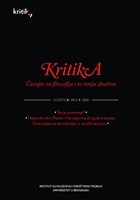ZAJEDNIČKA PERSPEKTIVA – POEZIJA, PERCEPCIJA I KINESTEZIJA POZIVA: POEZIJA NENADA GLIŠIĆA I PLESNI PERFORMANSI NEDE KOVINIĆ
JOINT PERSPECTIVE – THE POETRY, PERCEPTION AND KINAESTHETICS OF THE CALL: THE POETRY OF NENAD GLIŠIĆ AND THE DANCE PERFORMANCES OF NEDA KOVINIĆ
Author(s): Aleksandar MilankovićSubject(s): Theatre, Dance, Performing Arts, Serbian Literature, Theory of Literature, Sociology of Art, Sociology of Literature
Published by: Institut za filozofiju i društvenu teoriju
Keywords: poetry; performative art; engagement; sociality; we-perspective;
Summary/Abstract: There are two meanings of engagement in the analysis of the theory and practice of engaged art. The first, broader meaning implies that every form of public artwork is a form of engagement. It also implies that specific themes and motifs (primarily social and political motifs) or direction of artwork towards social problems – are a form of engagement. But, in the second and narrow meaning, engaged art implies specific, articulated social demands and appeals, followed by formal or informal group intentions, socially directed acts and distinguished joint perspective. In this paper we shall analyze the poetry of Nenad Glišić and the dance performances of Neda Kovinić as examples of engaged artworks in the narrow sense. In the poetry of Nenad Glišić, joint perspective reflects itself in the consequent and prominent use of the first-person plural as the lyrical subject in poems. Its distinguished “we” addresses the audience initiating joint experience. The author insists on the “we” dimension of poetry and its joint perspective, to emphasize the sociality of poetic act and its orientation towards social life, its destruction and constitution. In the performative acts of Neda Kovinić, the emphasis is dominantly placed on the joint perspective and on collective dimension – on the “we” of a performance. Performative acts become complex fields of kinaesthetic and perceptive interactions between individual and group intentions and acts. Group acts are the basic mode of transmitting social appeals – either planned and choreographed acts or spontaneous and unplanned group reactions to extraordinary social circumstances. It is evident that both poetry and dance performative acts reflect contemporary conceptions of social engagement and affirm and promote joint perspective as the key property of engagement in the narrow meaning. Besides, it is evident that both poetry and dance performative acts provide relevant empirical and conceptual basis for the understanding and analysis of the concepts and intuitions in social ontology.
Journal: Kritika: časopis za filozofiju i teoriju društva
- Issue Year: 2/2021
- Issue No: 1
- Page Range: 89-116
- Page Count: 28
- Language: Serbian

